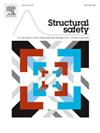Multi-output stochastic emulation with applications to seismic response correlation estimation
IF 6.3
1区 工程技术
Q1 ENGINEERING, CIVIL
引用次数: 0
Abstract
Stochastic emulation techniques represent a specialized surrogate modeling branch that is appropriate for applications for which the relationship between input and output is stochastic in nature. Their objective is to address the stochastic uncertainty sources by directly predicting the output distribution for a given input. An example of such application, and the focus of this contribution, is the estimation of structural response (engineering demand parameter) distribution in seismic risk assessment. In this case, the stochastic uncertainty originates from the aleatoric variability in the seismic hazard description. Note that this is a different uncertainty-source than the potential parametric uncertainty associated with structural characteristics or explanatory variables for the seismic hazard (for example, intensity measures), that are treated as the parametric input in surrogate modeling context. The key challenge in stochastic emulation pertains to addressing heteroscedasticity in the output variability. Relevant approaches to-date for addressing this challenge have focused on scalar outputs. In contrast, this paper focuses on the multi-output stochastic emulation problem and presents a methodology for predicting the output correlation matrix, while fully addressing heteroscedastic characteristics. This is achieved by introducing a Gaussian Process (GP) regression model for approximating the components of the correlation matrix, and coupling this approximation with a correction step to guarantee positive definite properties for the resultant predictions. For obtaining the observation data to inform the GP calibration, different approaches are examined, relying-or-not on the existence of replicated samples for the response output. Such samples require that, for a portion of the training points, simulations are repeated for the same inputs and different descriptions of the stochastic uncertainty. This information can be readily used to obtain observation for the response statistics (correlation or covariance in this instance) to inform the GP development. An alternative approach is to use as observations noisy covariance samples based on the sample deviations from a primitive mean approximation. These different observation variants lead to different GP variants that are compared within a comprehensive case study. A computational framework for integrating the correlation matrix approximation within the stochastic emulation for the marginal distribution approximation of each output component is also discussed, to provide the joint response distribution approximation.
多输出随机仿真及其在地震响应相关估计中的应用
随机仿真技术代表了一种专门的代理建模分支,适用于输入和输出之间的关系在本质上是随机的应用程序。他们的目标是通过直接预测给定输入的输出分布来解决随机不确定性源。这种应用的一个例子是地震风险评估中结构响应(工程需求参数)分布的估计。在这种情况下,随机不确定性来源于地震灾害描述中的任意变率。请注意,这与与地震危险的结构特征或解释变量(例如,强度测量)相关的潜在参数不确定性是不同的不确定性来源,后者在替代建模上下文中被视为参数输入。随机仿真的关键挑战在于如何处理输出变异性中的异方差。迄今为止应对这一挑战的相关方法主要集中在标量输出上。相比之下,本文主要研究多输出随机仿真问题,并提出了一种预测输出相关矩阵的方法,同时充分解决了异方差特性。这是通过引入高斯过程(GP)回归模型来逼近相关矩阵的组成部分,并将此近似与校正步骤相结合,以保证结果预测的正定性质来实现的。为了获得观测数据以通知GP校准,检查了不同的方法,是否依赖于响应输出的复制样本的存在。这样的样本要求,对于一部分训练点,对相同的输入和不同的随机不确定性描述进行重复模拟。该信息可以很容易地用于获得响应统计数据的观察结果(在本例中为相关性或协方差),以通知GP开发。另一种方法是使用基于样本偏离原始均值近似的噪声协方差样本作为观测值。这些不同的观测变量导致不同的GP变量,在一个全面的案例研究中进行比较。本文还讨论了在随机仿真中对各输出分量的边际分布近似积分相关矩阵近似的计算框架,以提供联合响应分布近似。
本文章由计算机程序翻译,如有差异,请以英文原文为准。
求助全文
约1分钟内获得全文
求助全文
来源期刊

Structural Safety
工程技术-工程:土木
CiteScore
11.30
自引率
8.60%
发文量
67
审稿时长
53 days
期刊介绍:
Structural Safety is an international journal devoted to integrated risk assessment for a wide range of constructed facilities such as buildings, bridges, earth structures, offshore facilities, dams, lifelines and nuclear structural systems. Its purpose is to foster communication about risk and reliability among technical disciplines involved in design and construction, and to enhance the use of risk management in the constructed environment
 求助内容:
求助内容: 应助结果提醒方式:
应助结果提醒方式:


